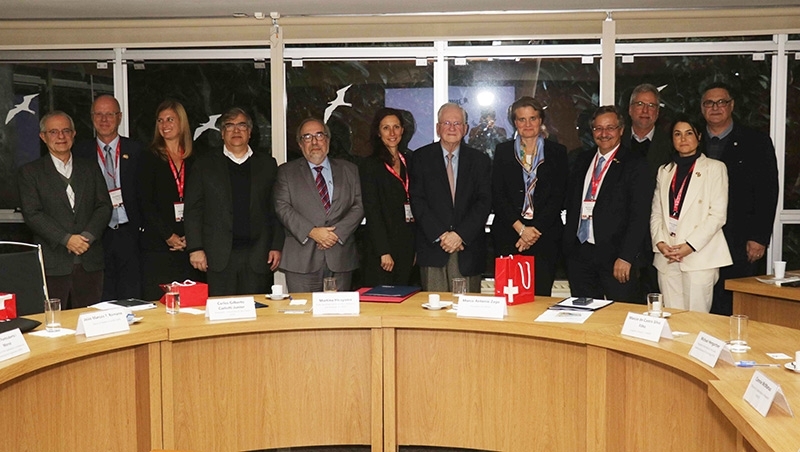


Similar programs and FAPESP’s pragmatism arouse interest in intensifying collaboration and joint calls for proposals involving research centers in Switzerland and São Paulo (photo: Felipe Maeda/Agência FAPESP)
Published on 07/24/2023
By Maria Fernanda Ziegler | Agência FAPESP – Senior executives of FAPESP and São Paulo state’s three public universities met on July 4 with Switzerland’s State Secretary for Education, Research and Innovation and representatives of Swiss research institutions, research funders and companies to intensify cooperation agreements and, above all, to foster new partnerships.
The first point discussed was a plan to increase Swiss interaction with centers of excellence such as FAPESP’s Engineering Research Centers (ERCs) and Research, Innovation and Dissemination Centers (RIDCs), which support long-term research associated with companies or governmental entities.
“I can see we have many similarities in terms of the models and frameworks used to fund research,” said Martina Hirayama, Swiss State Secretary for Education, Research and Innovation. “Our centers of excellence are an example. In Switzerland, they’re called National Centers of Competence and funded by the Swiss National Science Foundation [SNSF]. I believe it would be worth taking advantage of these similarities to create mechanisms for research collaboration involving our centers of excellence.”
FAPESP currently funds 22 RIDCs that conduct projects lasting up to ten years in the areas of health, disease processes, physics, chemistry, biology and mathematics. “The RIDCs are centers of long-term research excellence and candidates for cooperation with Swiss centers of excellence,” said Marco Antonio Zago, President of FAPESP.
The ERCs are established by FAPESP in partnership with companies or organizations such as GSK, Shell, EMBRAPA, Equinor, Grupo São Martinho, Koppert, IBM, Fundação Maria Cecilia Souto Vidigal, Erickson, Braskem, Embraer and Brazil’s Ministry of Science, Technology and Innovation. They are hosted by universities and research institutions. “It would be very interesting to have a program with Switzerland involving these centers. The ERCs are funded for ten years by FAPESP and partner companies. In the case of the ERC with Shell, for example, the company is investing five times more than FAPESP. They’re centers of excellence, with 20 scientists conducting problem-oriented research in pursuit of clearly defined results,” Zago said.
Another goal, Hirayama stressed, is strengthening the cooperation agreement signed in 2020 between FAPESP and SNSF. Four calls for proposals have been issued and nine research projects funded under this agreement. “I’d like to know the reasons for these fairly low numbers,” she said. “I believe we can intensify this partnership. We’re also interested in stepping up collaboration in research for innovation. In Switzerland, we have a program called Bridge, which offers funding at the interface of basic research and science-based innovation.”
Although the results of the FAPESP-SNSF agreement have been limited so far, the number of collaborations between São Paulo-based and Swiss researchers is far greater. According to statistics presented during the meeting, there are 547 such collaborations including grants and fellowships.
“The agreement between FAPESP and SNSF to hold joint calls for research proposals has received few submissions. However, it’s important to note that research collaboration between São Paulo and Switzerland is far more extensive if we take into account the institutions that collaborate directly. My suggestion, therefore, is that we work on increasing these connections,” Zago said.
For Marcio de Castro Silva Filho, FAPESP’s Scientific Director, there is flexibility for creation of new calls. “FAPESP is very flexible, and we’re willing to design calls for proposals, research programs and partnerships that meet both our own objectives and those of our Swiss colleagues. We have many funding opportunities and models for basic and applied research, as well as opportunities for research in interaction with private enterprise and government,” he said.
The participants in the meeting also discussed the most relevant topics for researchers to collaborate on, such as astronomy and physics on the Swiss side, and health, biodiversity and dentistry on the São Paulo side.
It is worth noting that the European Organization for Nuclear Research (CERN), which runs the world’s largest particle accelerator, the Large Hadron Collider (LHC), is headquartered in Switzerland. In Brazil, construction of Sirius, a fourth-generation particle accelerator, is nearing completion at the Brazilian Center for Research in Energy and Materials (CNPEM) in Campinas, São Paulo state.
Researchers funded by FAPESP have used workstations at Sirius even before its completion. Indeed, the first experiment conducted there was performed by researchers affiliated with the Center for Innovation in Biodiversity and Drug Discovery (CIBFar), a RIDC supported by FAPESP, to look for a COVID-19 drug candidate (read more at: agencia.fapesp.br/34526).
“I can see you’re very pragmatic. We’d like to work that way in Switzerland. I believe we have plenty of potential. I’d like to stress our special interest in partnering with researchers who work at Sirius,” said Michael Hengartner, Chair of the Board of the Swiss Federal Institutes of Technology (ETH).
Source: https://agencia.fapesp.br/41960